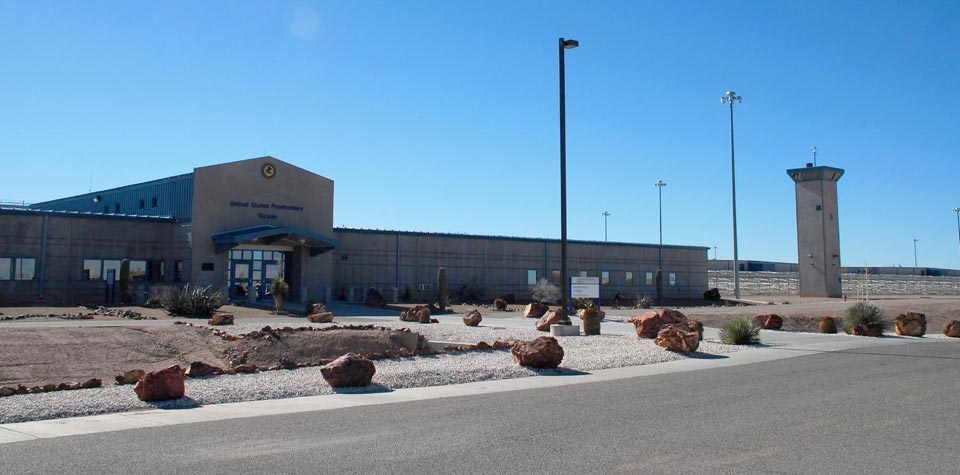
23 Feb BOP Transparency Vows Over USP Tucson Gun Incident Meant Nothing
On Sunday, Nov. 13, 2022, a federal prisoner at the minimum-security satellite camp at USP Tucson tried to murder his wife in the camp’s visiting room. Thankfully, the pistol Jaime had didn’t go off any of the times he pulled the trigger. Jaime apparently used the wrong bullet (.25 caliber ammo in a .22 pistol). Instead of killing Ismaela, his wife, the bullets fell to the floor.
The day after the attempted shooting, on Nov. 14, 2022, the Associated Press published this story on the incident, describing what happened after the attempted shooting as follows: “Officials said the inmate was restrained and the firearm was seized.” And the day after that, on Nov. 15, 2022, the AP published this follow-up report that provided the public with the first inside perspective on what happened two days earlier. As is almost always the case, that inside perspective came exclusively from the Bureau of Prisons.
Collette Peters, the BOP’s new Director, told the AP that it “was a ‘terrifying incident to have had happened.’ ” But, the AP’s initial story said, “Peters has vowed to bring new transparency to an agency that has long been a haven of secrecy and coverups.”
It’s now been more than three months since the BOP narrowly avoided having a room filled with women, children, a senior and a few minimum security “campers” watch as a husband executed his wife. How has the new BOP Director’s transparency vow held up over the past 102 days? If you ask the people who were in that visiting room or just outside of it on that terrifying Sunday morning, the answer is a clear one: Not good. Not good at all.
The BOP’s camps aren’t like the prisons you see on TV. There are “no bars” and “no barbed wire.” And when it comes to security, everything is “lax.”
Most of the people reading this probably haven’t been to one of the BOP’s minimum-security satellite camps. So, when I talk about a prison, you’re imagining something like in The Shawshank Redemption. That’s not what these camps are like.
As one woman who regularly visited the satellite camp at USP Tucson told me, it’s more like “a dorm room.” “There’s no bars, no barbed wire,” she said. “It really is time out for old men. It doesn’t look like a prison.”
And when it comes to visitation, another person who served time in another camp told me, the BOP is “pretty lax.” He said that his loved one “could have passed [him] anything” and “could have easily slipped [him] a weapon, a knife, a gun” when she visited. BOP staff, he said, “would have had no clue.”
In fact, at his camp, some of the BOP staff didn’t even bother searching the campers. “We were supposed to be totally strip searched going in … you have to bend over, spread your … the whole deal, and then you get dressed, and they let you do your visit. And then when you’re done with your visit, they’re supposed to do it again,” he explained. But it rarely happened.
Things were no different at USP Tucson. According to one camper, some campers got light pat-downs; others got no pat-down at all. And according to the loved ones I spoke with who visited regularly, there’s no security at all for them. “Through the security, I’ve never been checked. I’ve never been searched. There’s not metal detectors,” one woman told me. “It’s like a hospital lobby, I guess is the best way to put it.”
On Nov. 13, 2022, an adequate pat-down might have made all the difference.

Visitors at USP Tucson’s camp on Nov. 13, 2022, went from trying to decide whether to sit inside or on the patio to running for their lives in a matter of seconds.
Considering how “lax” these security protocols are, it’s not particularly surprising that someone could end up with a gun pointed at their head during a visit. What is surprising, though, is how ill equipped a federal agency that costs taxpayers around $8 billion per year was to deal with it.
According to those in the visiting room on Nov. 13, 2022, Jaime came in and met with Ismaela privately before their two teenage kids were supposed to join them. During their conversation, Jaime got up and went to the restroom. As he exited the restroom and his kids signed the check-in list in the waiting area, all hell broke lose.
Jaime pulled a .22 pistol from his waistband and walked up to his wife. The BOP staff did nothing. Jaime raised the gun and pointed it directly at Ismaela’s head. The BOP staff did nothing. Ismaela begged for her life. Their kids begged for help. The other visitors and campers screamed for help and ran for their lives. Still, the BOP staff did nothing.
Over the course of the next few minutes, Jaime, who had at least one other clip and a suicide note with him that day, pulled the trigger. Then he pulled it again. And again. And again. Luckily, the bullets fell to the ground.
With a gun pointed at her head, at her chest and in her side during the altercation, Ismaela fought for her life. She pushed and shoved Jaime the best that she could. She tried to crawl toward a door every chance she had. And she begged and begged and begged for help. The BOP staff member in the room, referred to as “Officer Rancinos” by the people I talked to, ran out of the room, closed the door and literally looked the other way.
As Jaime began striking his wife with the pistol and his fists, BOP staff waited outside the room, telling the kids that there was nothing they could do.
As the struggle continued, Jaime briefly gave up on shooting his wife and began beating her with the gun and his fists instead. Their son and daughter begged BOP staff over and over again to go into the room and do something. Still, BOP staff did nothing. One person I talked to said that most of the officers actually left the building entirely until backup arrived.
Ismaela and Jaime’s teenage son tried to come in the room to save his mom. Jaime pointed the gun at him instead and told him to leave: “Get the fuck out of here!”
As she watched her son flee for his own safety, Ismaela kept begging and begging for someone to come help. As Jaime had her down on the floor with the gun to her head once again, she begged him to let her live. “Forgive me, Jaime. Forgive me. Please don’t do this, Jaime. Please don’t do this in front of my kids. Don’t do this in front of the kids. Please don’t kill me in front of them. Please don’t do it.”
One of the other women there that I spoke with got emotional as she told me about Ismaela’s screams. “Everything seemed fine, and then … there were some sounds coming from inside [the visiting room], and I don’t know how to describe it, but when you hear something and you think, ugh, that’s … that’s not right, that doesn’t sound right,” she told me. “You could hear this woman’s … scream that I will never forget.”
The officers stayed outside. But one man, another camper who was in the room to photograph the campers and their loved ones that day, had the courage to do something.
The camp photographer risked his life to save Ismaela, her kids and likely others inside the visiting room while BOP staff did almost nothing.
Jaime’s wife might be dead today if it wasn’t for the camp photographer. As time passed, Ismaela and Jaime’s kids were still pleading with BOP staff to do something to save their mom. “Please save my mom … help her,” their teenage son begged the officer closest to the door.
The photographer, who witnesses primarily referred to as “Vargas,” heard Ismaela’s screams from inside the room as well as the children’s pleas and couldn’t simply stand there and wait. So Vargas said “Fuck it!” and went in.
He ran in the room, tackled Jaime to the floor and tried to hold him off of Ismaela as best he could. Jaime put the gun to Vargas’s head as the struggle ensued. But together, Ismaela and Vargas were able to pry the gun out of Jaime’s hands and kick it across the floor.
To his credit, after Ismaela and Vargas were able to kick the gun away, another officer came in and picked it up. That was more help than Ismaela and Vargas got from Officer Racinos, who witnesses said practically froze before running out of the room. According to multiple people that I spoke with, Officer Racinos may have called for backup and managed to press the “deuces,” i.e., facility’s version of a panic button. But as soon as the visiting room’s doors opened, he was the first one out the door.
After Ismaela and Vargas disarmed Jaime, Vargas found himself on the end of the officers’ loaded AR-15s and handguns. Thankfully, the officer who picked up Jaime’s gun made sure his colleagues knew Vargas was “good.” The guns were then lowered.
One of the witnesses I spoke to said that when “backup” finally arrived, they were “ready for war.” By that point, though, Ismaela (with Vargas’s help) had already saved herself.
BOP staff eventually got Ismaela away from Jaime and out of the visiting room. Then they handcuffed her and her daughter and interrogated them.
Incredibly, Ismaela’s suffering didn’t end after the attack. BOP staff eventually took her out to the parking lot. But they didn’t let her leave or provide any medical treatment for her injuries. Instead, they handcuffed her and her crying daughter and accused them of giving Jaime the gun he used to try to kill them. BOP staff wanted to handcuff her son, too. But his mom pleaded with the officers not to because he is a minor and had fainted.
The other visitors stuck in the parking lot were eventually allowed to comfort the traumatized family. The AP’s initial reporting stated that “no one was injured.” But one witness I spoke with told me that Ismaela’s face was injured and “bloody.” Numerous witnesses confirmed that the son fainted. Yet BOP staff did nothing to help. Instead, it was another one of the visitors who went to get a bottle of water out of her car for them.
BOP staff was, however, courteous enough to ask if any of them had been shot. But they couldn’t even ask that question in a humane way. The guard asked us “if we had any holes in us,” one woman told me. “That was a weird question.”
Eventually, two buses arrived. BOP staff loaded the campers, approximately 90 men who had been handcuffed behind their back with zip ties on the ground in the hot Arizona sun for more than an hour, and took them to one of two final destinations: a cell in the maximum-security facility at USP Tucson or, for the campers in or near the visiting room that Sunday, solitary confinement (aka the SHU). And, for most of them, that’s where they’ve been ever since.

Officer Racinos got paid time off for the “stress” he endured. The hero, the victim and the witnesses got nothing — and, sometimes, worse than nothing.
Unlike Jaime’s wife, her children and the photographer who risked his life to help, Officer Racinos, the officer who ran out of the room and did practically nothing, has been receiving nonstop help from the BOP since that day. He immediately enjoyed paid time off for the “stress” he endured during the incident. And he hasn’t faced any accountability for his actions (or lack thereof). Neither has anyone else with the BOP.
Warden Gutierrez and Camp Administrator Chaffey haven’t faced any accountability either. The closest thing to accountability for these two was a decision from the BOP at either the regional or national level to thwart their efforts to have these campers scattered in facilities all over the country and away from their loved ones.
A lot of the people I talked to think that’s why Warden Gutierrez and Camp Administrator Chaffey have kept the men in the maximum-security facility for months on end: the embarrassment they suffered for allowing something like this to happen at their camp and not getting their way afterward.
The campers, on the other hand, have spent more than three months in USP Tucson’s maximum-security cells or, even worse, the SHU. They haven’t received any help. Their loved ones, including the woman who was almost murdered and her children, haven’t received any help either (aside from, I guess, being asked if they “had any holes”). BOP staff couldn’t even manage a phone call.
If anything, the campers have been punished. These punishments have came in a variety of forms, ranging from temporarily cutting off communication to the outside world to feeding them food that’s been sitting out for too long.
Communication
Perhaps the most meaningful example of the punishment the campers who witnessed the incident have received involves communication. At first, BOP staff promised the campers and their loved ones that they’d be able to talk to each other to make sure they were okay later that day on Nov. 13, 2022. As it turns out, the BOP didn’t let the men call or email their wives or children for multiple weeks after this took place. And when their wives called the facility themselves, the message they got was as sarcastic as it was useless: “He’s still in the state, so that’s good news for you.”
In a similar bait-and-switch fashion, the BOP also allowed the men to write letters to their loved ones shortly after the incident. But the letters were never sent and were eventually returned. According to one person I spoke with, most officers legitimately believed they were going to allow the letters to be mailed. But, this person said, Administrator Chaffey refused to provide stamps.
Christmas Bags
Maybe a better example involves comparing their treatment to the treatment of the maximum-security detainees assigned to the same facility. On Christmas, people in BOP custody usually receive bags with, as one person described them to me, “candy, junk food, different things in there.” In 2022, however, those bags only went to the maximum-security detainees at USP Tucson, not the men from the satellite camp.
In the scheme of things, the men and their loved ones don’t really care about the candy or junk food. But the disparity in who received those bags was a tangible reminder about how much better the maximum-security detainees have been treated than the minimum-security ones who don’t even belong in that facility. Whether it’s the quality of food they receive or the time they get outside of their cells, it’s the campers, not their maximum-security counterparts, who are punished most.
Clothing and Shoes
The punishment extended all the way to the men’s clothes and shoes. Two of the men I’ve seen messages from complained that their belongings — their clothes, their shoes and even things like wedding rings, books and commissary food — were thrown out. They’ve been stuck in shower sandals for 100 days straight even though they were only permitted a shower or two (or eventually three) per week for the first month.
Old, Stale Food
Then there is access to commissary. The campers have finally been allowed some access to commissary to buy things like medicine and shampoo. But multiple people told me that they’re not allowed to purchase food from commissary. This is especially troubling for these men because they aren’t able to eat on a regular basis.
One woman told me about her loved one regularly having to choose between not eating and eating old, stale food because of how late the meals come to the campers. Another told me that the best thing her loved one has eaten in three months was a stale peanut butter and jelly sandwich. After all, she said, it beats (possibly spoiled) bologna.
Another person I spoke with told me that the BOP has refused to accommodate food allergies for these men since the move. Because peanut butter and jelly sandwiches apparently remain a go-to meal for the campers in the maximum-security facility, this means those with peanut allergies simply cannot eat.
Several of the wives and family members I spoke with also expressed concern over the health and safety of their loved ones inside. Many of the men have lost a significant amount of weight since they were moved from the camp. Some have lost as much as 40 pounds.
Additionally, unlike minimum-security satellite camps, maximum-security prisons can be, frankly, dangerous. While these men are used to the ordinarily liberal protocols common at minimum-security satellite camps, they’re now becoming more familiar with facility-wide lockdowns because of violence between detainees, intentional damage to plumbing and more at maximum-security facilities like USP Tucson.
Sunlight
Maybe the clearest example of the punishment is the simplest one to describe: None of these men have been outside since Nov. 13, 2022. None of them. Not for even an hour.
Retaliation
All of the people I spoke with also have the same level of fear. Everyone is scared that they or their loved ones will be punished for talking. They’ve tried reaching out to major news outlets. But none have been willing to expand on the original BOP-friendly version of events already out there. Jaime’s wife even publicly commented on this story in Forbes. No one reached out.
As more efforts are made to tell their story, the fears the campers and their loved ones have are materializing. One woman I spoke with told me that she heard that the BOP had already moved someone back to the SHU “because they [Warden Gutierrez and Administrator Chaffey] found out what he was doing.” Obviously, this is only a rumor. But the rumor itself has scared others into silence.
Unable to find anyone willing to listen in the media, some loved ones and campers turned to elected officials. Multiple people I spoke with reached out to elected officials in Arizona and around the country, including some with credibility when it comes to criminal justice and prison reform. Some said they’d need someone else to cover the story first. Others didn’t respond. And one couldn’t do anything without the woman’s name (and, absurdly, her social security number).
Ultimately, most of the people I spoke with didn’t want me to use their name. The ones that were okay with it didn’t want people to know I talked to them. For the most part, I obliged. The reality is that everyone I’ve spoken to could have been killed on Nov. 13, 2022. Sheer dumb luck, a brave wife and a camp photographer saved countless lives. The least I can do is honor their anonymity wishes.

Three months later, the BOP has Jaime in a medium-security facility while the other campers are stuck in a maximum-security one.
Unbelievably, Jaime made out better than the people he might have killed. As of the date of this story, Jaime is detained in a medium-security facility. Most of the campers he could have killed, on the other hand, are still in a maximum-security facility or, even worse, the SHU.
One camper, luckily, is not: the camp photographer. Originally, the BOP put him in the SHU with the rest of the campers who were in the visiting room on Nov. 13, 2022. Eventually, he, like the others, moved to regular maximum-security cells where most of them have stayed for three and a half months with no end in sight. Last week, though, the camp photographer was released to home confinement.
Housing someone who managed to gain access to a gun and bullets and used them to try to shoot his wife in a less secure facility than the people he could have shot might seem backwards. But it’s ordinary business for the BOP. As the AP indicated in its initial article on this incident, “[t]he Bureau of Prisons has been plagued by chronic mismanagement, misconduct and a severe staffing crisis.”
Yet when it comes to oversight, accountability for the BOP is virtually impossible to find. Take the First Step Act’s Time Credits Program as an example. The BOP completely botched the phase-in period and has been playing catch up ever since. Yet pushback from federal courts is almost nonexistent. This lack of accountability has led to organizations like FAMM calling on Congress to implement independent oversight over the troubled agency.
According to the agency’s website, the BOP “is an excellent steward of public funds.” Why can’t $8 billion a year do a little better than this?
The craziest thing about this entire situation is how lucky everyone was. Jaime could have killed his wife. And everyone else in or near that visiting room. I have no idea if that was his plan. But it could have been. But a little sheer dumb luck, a strong mom and a brave camper, not the BOP, stopped him.
Yet that’s not even close to the story the BOP told us despite, to use the AP’s phrasing, the agency’s “vow[] to bring new transparency to an agency that has long been a haven of secrecy and coverups.” Instead, thanks in part to the AP’s insistence on using the passive voice in situations like this, we were told an unremarkable story with no credit and no blame: “Officials said the inmate was restrained after the incident and the firearm was seized.”
The BOP’s budget was a whopping “$7,849.4 million” in 2022. (If you’re thinking that referring to $7.8 billion as “$7,800 million” seems weird, you’re not alone.) For 2023, the BOP asked for a $327.7 million raise, bumping that final number up to just over $8.1 billion or, as the BOP puts it, “$8,177.1 million” for the year. That’s a lot.
Perhaps some of that $8.1 billion can go toward camper and visitor security. That way, the next time this happens, there’s a better procedure in place than counting on sheer dumb luck or hoping the victim and a camper can save the day. Perhaps some of that $8.1 billion can also go to Ismaela and her children, all of whom continue to suffer as a result of what the BOP allowed to happen that Sunday morning back in November.
About the Author
Peter J. Tomasek is an attorney and writer for Interrogating Justice, a 501(c)(3) nonprofit organization that aims to help more Americans understand how the justice system is falling short through legal analyses and investigative reporting by attorneys, advocates and allies. Peter’s work focuses on holding governmental actors, including the Bureau of Prisons, judges, prosecutors and law enforcement, accountable. You can read his most recent work on the BOP’s implementation of the First Step Act Time Credits Program here. You can reach Peter at ptomasek@interrogatingjustice.org.

